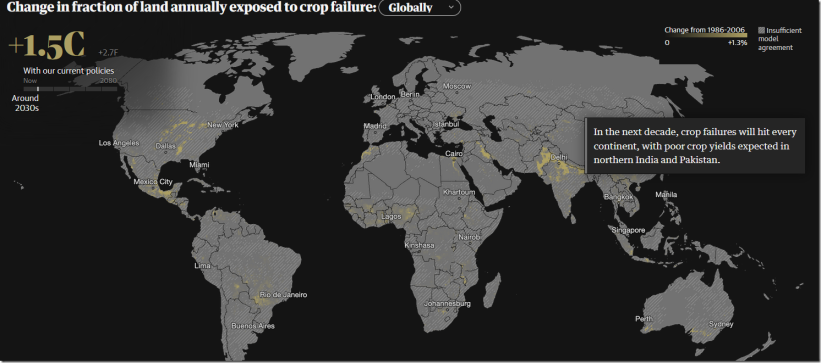Crop Failures & The “Climate Disaster”
By Paul Homewood | Not A Lot Of People Know That | October 26, 2021
We looked at this phony Guardian report the other day:
One section deals with what it calls crop failure:
It claims that once-a-decade droughts are becoming more frequent, in comparison with 1850-1900! This apparently comes from the IPCC, but who was counting droughts in the 19thC?
As with disaster databases, it is only in recent years that organisations have been set up to monitor humanitarian crises and provide aid. A hundred years ago, there was no internet, television or mobile phones to relay the news.
A famine in Madagascar would simply have happened without being noticed.
The Guardian then goes on to “prove” its point, by cherry picking droughts in Guatemala and Zambia, as if they had never happened before. They are not even in the same year!
The dip in agricultural production in Guatemala is evident in 2017, but the trend for both countries is remorselessly up.
https://www.fao.org/faostat/en/#compare
If there was any truth in the Guardian’s apocalyptic version of events, we would see global food production staggering from one crisis to another.
But we don’t.
The Guardian reckons that India and Pakistan will be particularly badly hit by crop failures, even in this decade:
But this goes totally opposite to what is actually happening there.
And long term monsoon trends clearly show that droughts are not becoming more severe or common in India, global warming or not. Most droughts are, in fact, associated with El Ninos, and not climate change:









First thing that comes to mind is that droughts and monsoonal rains can go and often do go hand in hand. This where regenerative ag has a role to play in any futuristic thinking. Cant keep fucking with the soil and keep getting away with it.
LikeLiked by 1 person
Does either “look” look at population growth and what I assume would be a burgeoning/disproportionate effect on poverty and nutritional health and their physical and mental manifestations between, say, 1850 and 2020 in terms of drought/climate/weather changes? What about migratory habits? How is the animal kingdom, with obvious effects on volume of food availability (both in the eating of “food” BY animals and then the eating of animals FOR “food” by humans), affected by these patterns? Aren’t such variables important and needful of attention in such “looks”?
LikeLike